overheating MITSUBISHI SHOGUN 2017 Owner's Manual (in English)
[x] Cancel search | Manufacturer: MITSUBISHI, Model Year: 2017, Model line: SHOGUN, Model: MITSUBISHI SHOGUN 2017Pages: 394, PDF Size: 19 MB
Page 94 of 394

NOTElWhen the vehicle has been refuelled, the
pointer in the fuel gauge takes a short while
to stabilize.
l The fuel gauge will not give an accurate in-
dication if the vehicle is refuelled with the ignition switch in the “ON” position.
l When the engine on diesel-powered vehicles
fails to operate due to running out of fuel, it may sometimes be difficult to start after re-
fueling. This is due to air entering the fuel
system. Therefore, air must be bled from the system. (Refer to “Bleeding the fuel system” on page 8-06.)
Fuel lid mark
The fuel lid mark (A) indicates that the fuel
tank filler door is located on the right side of the vehicle.
Low fuel warning lamp
E00508101778
The warning lamp (A) comes on when the
fuel level is getting low (approx. 10 litres )
with the ignition switch in the “ON” position.
Refuel as soon as possible.NOTEl On inclines or curves, due to the movement
of fuel in the tank, the low fuel warning lamp may indicate incorrectly.Water temperature gauge
E00500801519
The water temperature gauge indicates the
engine coolant temperature when the ignition
switch is in the “ON” position.
CAUTIONl If the indication needle enters the H zone
while the engine is running, it indicates that
the engine is possibly overheating. Immedi-
ately park your vehicle in a safe place and make the necessary corrections. (Refer to“Engine overheating” on page 8-04.)
While driving, care should always be taken
to maintain the normal operating tempera- ture.
Instruments
5-06OVWX17E1Instruments and controls5
Page 137 of 394
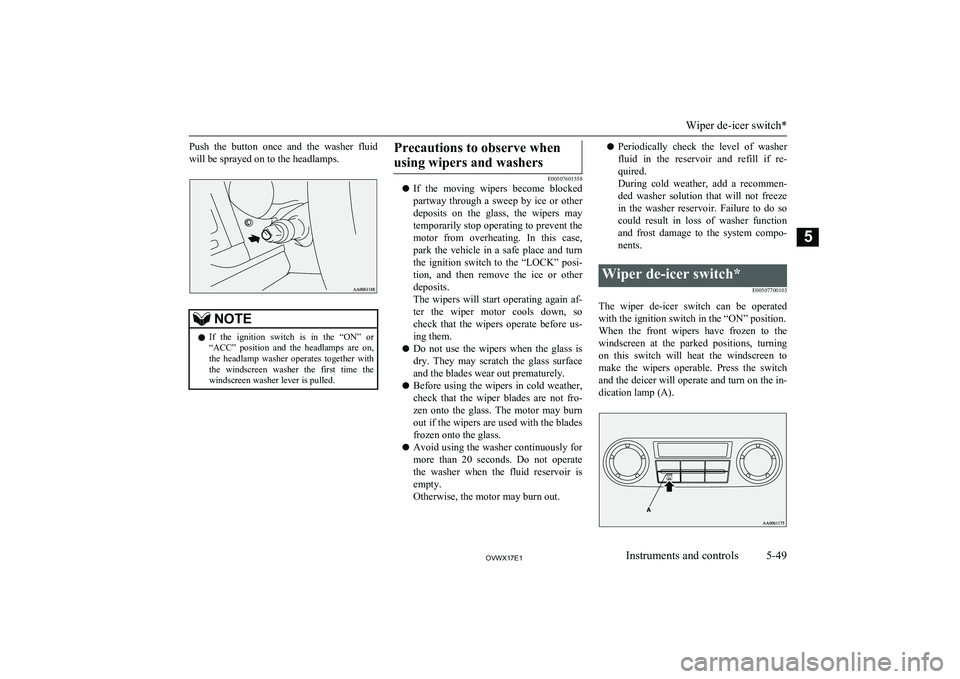
Push the button once and the washer fluidwill be sprayed on to the headlamps.NOTEl If the ignition switch is in the “ON” or
“ACC” position and the headlamps are on,
the headlamp washer operates together with the windscreen washer the first time thewindscreen washer lever is pulled.Precautions to observe when
using wipers and washers
E00507601558
l If the moving wipers become blocked
partway through a sweep by ice or other deposits on the glass, the wipers maytemporarily stop operating to prevent the
motor from overheating. In this case,
park the vehicle in a safe place and turn the ignition switch to the “LOCK” posi-
tion, and then remove the ice or other
deposits.
The wipers will start operating again af- ter the wiper motor cools down, so
check that the wipers operate before us-
ing them.
l Do not use the wipers when the glass is
dry. They may scratch the glass surface
and the blades wear out prematurely.
l Before using the wipers in cold weather,
check that the wiper blades are not fro- zen onto the glass. The motor may burn out if the wipers are used with the blades
frozen onto the glass.
l Avoid using the washer continuously for
more than 20 seconds. Do not operate the washer when the fluid reservoir isempty.
Otherwise, the motor may burn out.
l Periodically check the level of washer
fluid in the reservoir and refill if re- quired.
During cold weather, add a recommen-
ded washer solution that will not freeze
in the washer reservoir. Failure to do so could result in loss of washer functionand frost damage to the system compo- nents.Wiper de-icer switch*
E00507700103
The wiper de-icer switch can be operatedwith the ignition switch in the “ON” position.
When the front wipers have frozen to the windscreen at the parked positions, turning
on this switch will heat the windscreen to make the wipers operable. Press the switch
and the deicer will operate and turn on the in- dication lamp (A).
Wiper de-icer switch*
5-49OVWX17E1Instruments and controls5
Page 169 of 394
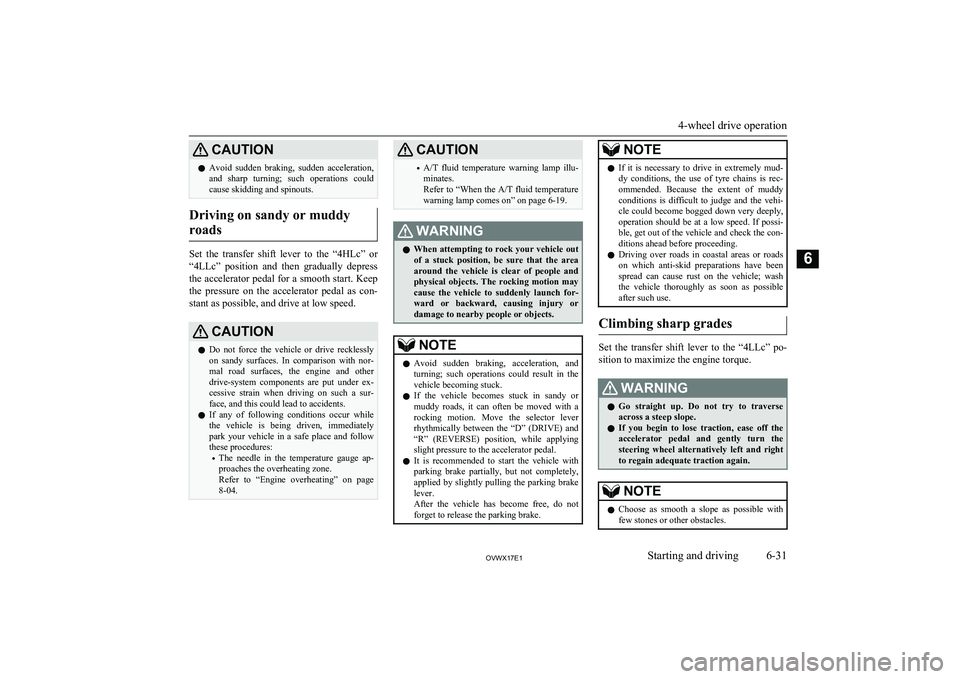
CAUTIONlAvoid sudden braking, sudden acceleration,
and sharp turning; such operations could
cause skidding and spinouts.
Driving on sandy or muddy
roads
Set the transfer shift lever to the “4HLc” or “4LLc” position and then gradually depress
the accelerator pedal for a smooth start. Keep
the pressure on the accelerator pedal as con- stant as possible, and drive at low speed.
CAUTIONl Do not force the vehicle or drive recklessly
on sandy surfaces. In comparison with nor-
mal road surfaces, the engine and other
drive-system components are put under ex- cessive strain when driving on such a sur-
face, and this could lead to accidents.
l If any of following conditions occur while
the vehicle is being driven, immediately park your vehicle in a safe place and follow these procedures:
• The needle in the temperature gauge ap-
proaches the overheating zone.
Refer to “Engine overheating” on page
8-04.CAUTION• A/T fluid temperature warning lamp illu-
minates.
Refer to “When the A/T fluid temperature
warning lamp comes on” on page 6-19.WARNINGl When attempting to rock your vehicle out
of a stuck position, be sure that the area
around the vehicle is clear of people and physical objects. The rocking motion may
cause the vehicle to suddenly launch for- ward or backward, causing injury or damage to nearby people or objects.NOTEl Avoid sudden braking, acceleration, and
turning; such operations could result in thevehicle becoming stuck.
l If the vehicle becomes stuck in sandy or
muddy roads, it can often be moved with a
rocking motion. Move the selector lever rhythmically between the “D” (DRIVE) and
“R” (REVERSE) position, while applying slight pressure to the accelerator pedal.
l It is recommended to start the vehicle with
parking brake partially, but not completely, applied by slightly pulling the parking brake
lever.
After the vehicle has become free, do not forget to release the parking brake.NOTEl If it is necessary to drive in extremely mud-
dy conditions, the use of tyre chains is rec-
ommended. Because the extent of muddy conditions is difficult to judge and the vehi- cle could become bogged down very deeply,
operation should be at a low speed. If possi-
ble, get out of the vehicle and check the con-
ditions ahead before proceeding.
l Driving over roads in coastal areas or roads
on which anti-skid preparations have been
spread can cause rust on the vehicle; wash
the vehicle thoroughly as soon as possible after such use.
Climbing sharp grades
Set the transfer shift lever to the “4LLc” po-
sition to maximize the engine torque.
WARNINGl Go straight up. Do not try to traverse
across a steep slope.
l If you begin to lose traction, ease off the
accelerator pedal and gently turn the steering wheel alternatively left and right
to regain adequate traction again.NOTEl Choose as smooth a slope as possible with
few stones or other obstacles.
4-wheel drive operation
6-31OVWX17E1Starting and driving6
Page 173 of 394
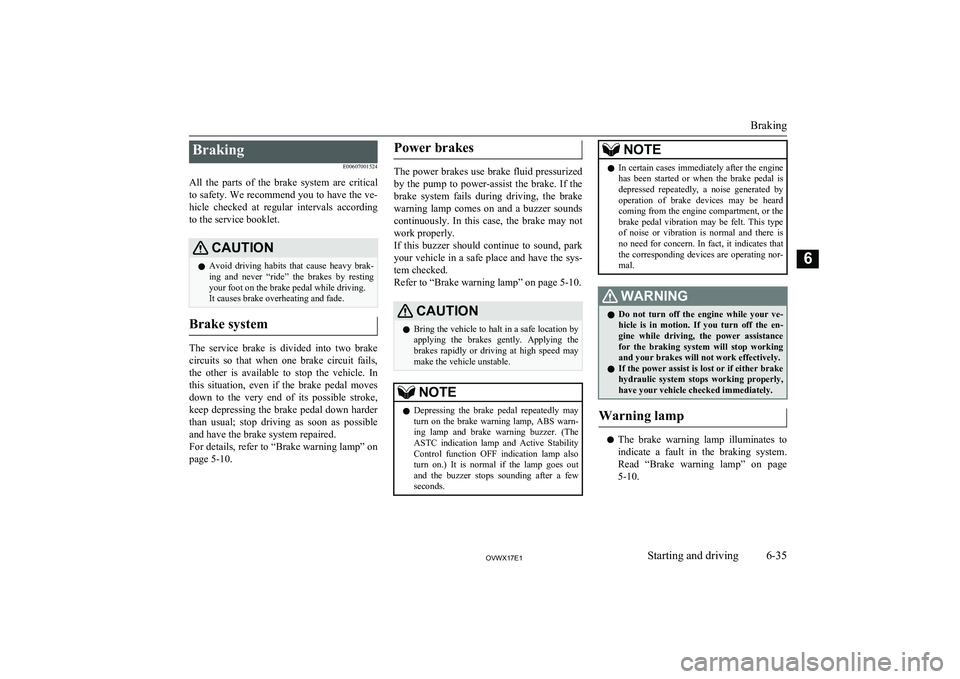
BrakingE00607001524
All the parts of the brake system are critical
to safety. We recommend you to have the ve- hicle checked at regular intervals according
to the service booklet.CAUTIONl Avoid driving habits that cause heavy brak-
ing and never “ride” the brakes by resting
your foot on the brake pedal while driving.
It causes brake overheating and fade.
Brake system
The service brake is divided into two brake
circuits so that when one brake circuit fails, the other is available to stop the vehicle. In
this situation, even if the brake pedal moves down to the very end of its possible stroke,
keep depressing the brake pedal down harder than usual; stop driving as soon as possible
and have the brake system repaired.
For details, refer to “Brake warning lamp” on
page 5-10.
Power brakes
The power brakes use brake fluid pressurized
by the pump to power-assist the brake. If the brake system fails during driving, the brake
warning lamp comes on and a buzzer sounds continuously. In this case, the brake may not
work properly.
If this buzzer should continue to sound, park your vehicle in a safe place and have the sys-tem checked.
Refer to “Brake warning lamp” on page 5-10.
CAUTIONl Bring the vehicle to halt in a safe location by
applying the brakes gently. Applying the
brakes rapidly or driving at high speed may
make the vehicle unstable.NOTEl Depressing the brake pedal repeatedly may
turn on the brake warning lamp, ABS warn-ing lamp and brake warning buzzer. (The
ASTC indication lamp and Active Stability
Control function OFF indication lamp also
turn on.) It is normal if the lamp goes out and the buzzer stops sounding after a few
seconds.NOTEl In certain cases immediately after the engine
has been started or when the brake pedal is
depressed repeatedly, a noise generated by operation of brake devices may be heard coming from the engine compartment, or the
brake pedal vibration may be felt. This type
of noise or vibration is normal and there is
no need for concern. In fact, it indicates that
the corresponding devices are operating nor-
mal.WARNINGl Do not turn off the engine while your ve-
hicle is in motion. If you turn off the en-
gine while driving, the power assistance
for the braking system will stop working and your brakes will not work effectively.
l If the power assist is lost or if either brake
hydraulic system stops working properly,
have your vehicle checked immediately.
Warning lamp
l The brake warning lamp illuminates to
indicate a fault in the braking system.
Read “Brake warning lamp” on page
5-10.
Braking
6-35OVWX17E1Starting and driving6
Page 174 of 394
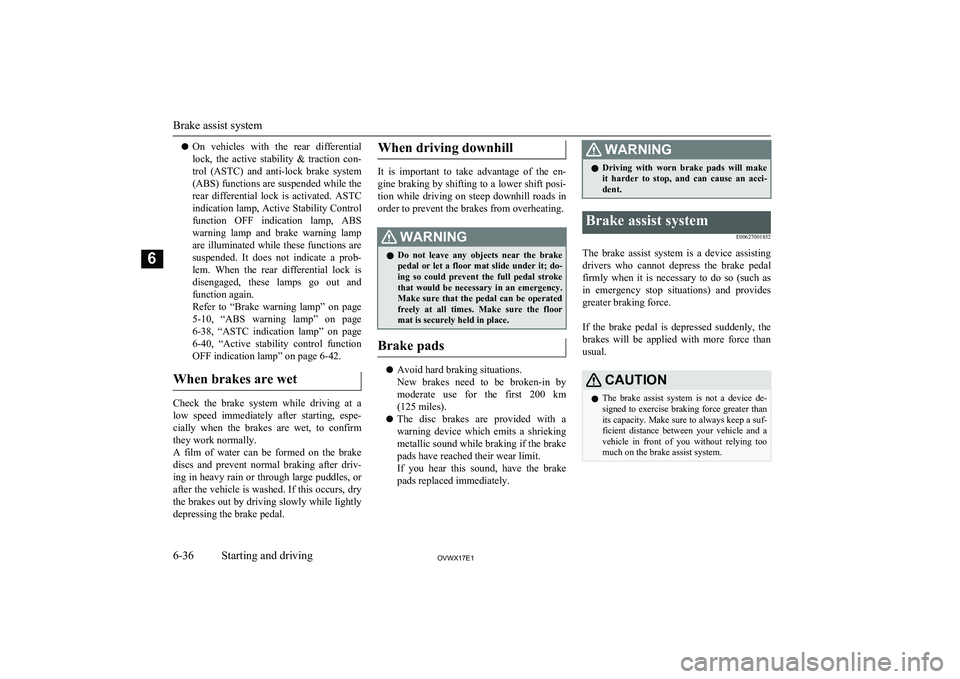
lOn vehicles with the rear differential
lock, the active stability & traction con- trol (ASTC) and anti-lock brake system
(ABS) functions are suspended while the
rear differential lock is activated. ASTC indication lamp, Active Stability Controlfunction OFF indication lamp, ABS
warning lamp and brake warning lamp are illuminated while these functions are
suspended. It does not indicate a prob- lem. When the rear differential lock is
disengaged, these lamps go out and function again.
Refer to “Brake warning lamp” on page
5-10 , “ABS warning lamp” on page
6-38 , “ASTC indication lamp” on page
6-40 , “Active stability control function
OFF indication lamp” on page 6-42.
When brakes are wet
Check the brake system while driving at a
low speed immediately after starting, espe- cially when the brakes are wet, to confirmthey work normally.
A film of water can be formed on the brake
discs and prevent normal braking after driv-
ing in heavy rain or through large puddles, or after the vehicle is washed. If this occurs, dry
the brakes out by driving slowly while lightly depressing the brake pedal.
When driving downhill
It is important to take advantage of the en-
gine braking by shifting to a lower shift posi- tion while driving on steep downhill roads in order to prevent the brakes from overheating.
WARNINGl Do not leave any objects near the brake
pedal or let a floor mat slide under it; do- ing so could prevent the full pedal strokethat would be necessary in an emergency.
Make sure that the pedal can be operated freely at all times. Make sure the floor mat is securely held in place.
Brake pads
l Avoid hard braking situations.
New brakes need to be broken-in by
moderate use for the first 200 km (125 miles).
l The disc brakes are provided with a
warning device which emits a shrieking
metallic sound while braking if the brake pads have reached their wear limit.
If you hear this sound, have the brake pads replaced immediately.
WARNINGl Driving with worn brake pads will make
it harder to stop, and can cause an acci-
dent.Brake assist system
E00627001852
The brake assist system is a device assistingdrivers who cannot depress the brake pedalfirmly when it is necessary to do so (such as
in emergency stop situations) and provides
greater braking force.
If the brake pedal is depressed suddenly, the brakes will be applied with more force thanusual.
CAUTIONl The brake assist system is not a device de-
signed to exercise braking force greater than its capacity. Make sure to always keep a suf-
ficient distance between your vehicle and a
vehicle in front of you without relying too much on the brake assist system.
Brake assist system
6-36OVWX17E1Starting and driving6
Page 293 of 394
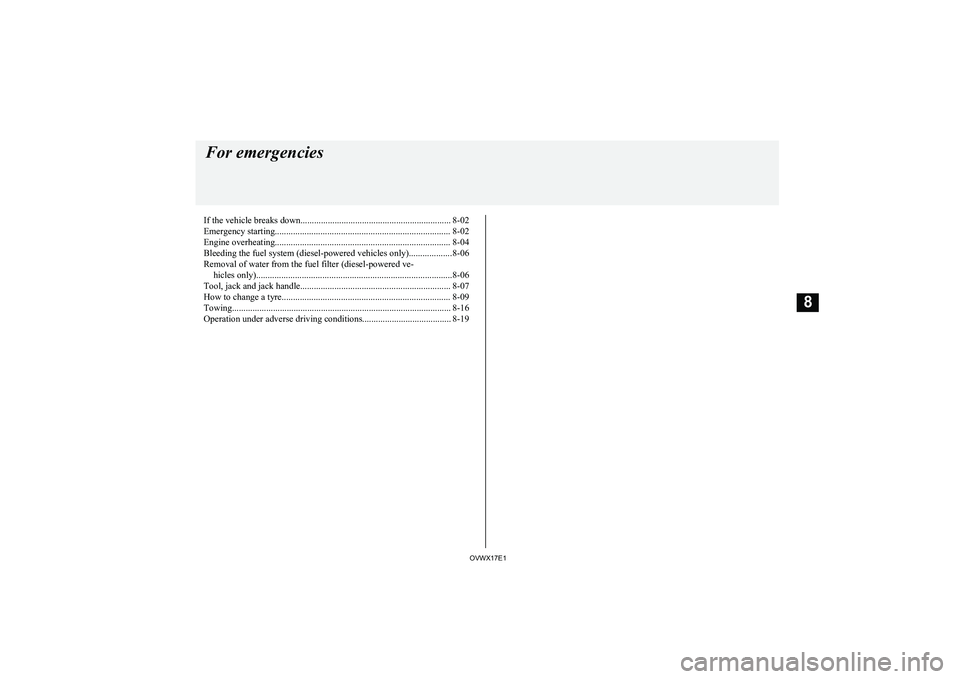
If the vehicle breaks down.................................................................. 8-02Emergency starting............................................................................. 8-02
Engine overheating............................................................................. 8-04
Bleeding the fuel system (diesel-powered vehicles only)...................8-06
Removal of water from the fuel filter (diesel-powered ve- hicles only)......................................................................................8-06
Tool, jack and jack handle.................................................................. 8-07
How to change a tyre.......................................................................... 8-09
Towing................................................................................................ 8-16
Operation under adverse driving conditions....................................... 8-19For emergencies
OVWX17E18
Page 296 of 394
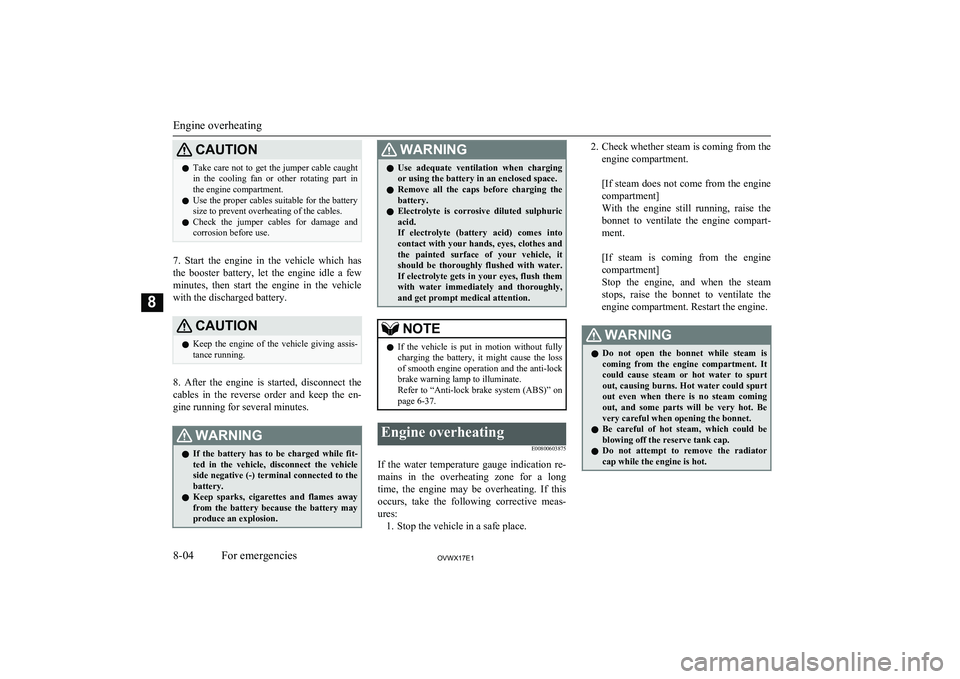
CAUTIONlTake care not to get the jumper cable caught
in the cooling fan or other rotating part in
the engine compartment.
l Use the proper cables suitable for the battery
size to prevent overheating of the cables.
l Check the jumper cables for damage and
corrosion before use.
7. Start the engine in the vehicle which has
the booster battery, let the engine idle a few
minutes, then start the engine in the vehicle
with the discharged battery.
CAUTIONl Keep the engine of the vehicle giving assis-
tance running.
8. After the engine is started, disconnect the
cables in the reverse order and keep the en-
gine running for several minutes.
WARNINGl If the battery has to be charged while fit-
ted in the vehicle, disconnect the vehicle side negative (-) terminal connected to the
battery.
l Keep sparks, cigarettes and flames away
from the battery because the battery may
produce an explosion.WARNINGl Use adequate ventilation when charging
or using the battery in an enclosed space.
l Remove all the caps before charging the
battery.
l Electrolyte is corrosive diluted sulphuric
acid.
If electrolyte (battery acid) comes into contact with your hands, eyes, clothes and
the painted surface of your vehicle, it should be thoroughly flushed with water.If electrolyte gets in your eyes, flush them
with water immediately and thoroughly, and get prompt medical attention.NOTEl If the vehicle is put in motion without fully
charging the battery, it might cause the loss
of smooth engine operation and the anti-lock brake warning lamp to illuminate.
Refer to “Anti-lock brake system (ABS)” on
page 6-37.Engine overheating
E00800603875
If the water temperature gauge indication re-
mains in the overheating zone for a long
time, the engine may be overheating. If this occurs, take the following corrective meas-
ures: 1. Stop the vehicle in a safe place.
2. Check whether steam is coming from the
engine compartment.
[If steam does not come from the engine
compartment]
With the engine still running, raise the bonnet to ventilate the engine compart-
ment.
[If steam is coming from the engine
compartment]
Stop the engine, and when the steam
stops, raise the bonnet to ventilate the
engine compartment. Restart the engine.WARNINGl Do not open the bonnet while steam is
coming from the engine compartment. It
could cause steam or hot water to spurt out, causing burns. Hot water could spurt
out even when there is no steam coming out, and some parts will be very hot. Be
very careful when opening the bonnet.
l Be careful of hot steam, which could be
blowing off the reserve tank cap.
l Do not attempt to remove the radiator
cap while the engine is hot.
Engine overheating
8-04OVWX17E1For emergencies8
Page 297 of 394
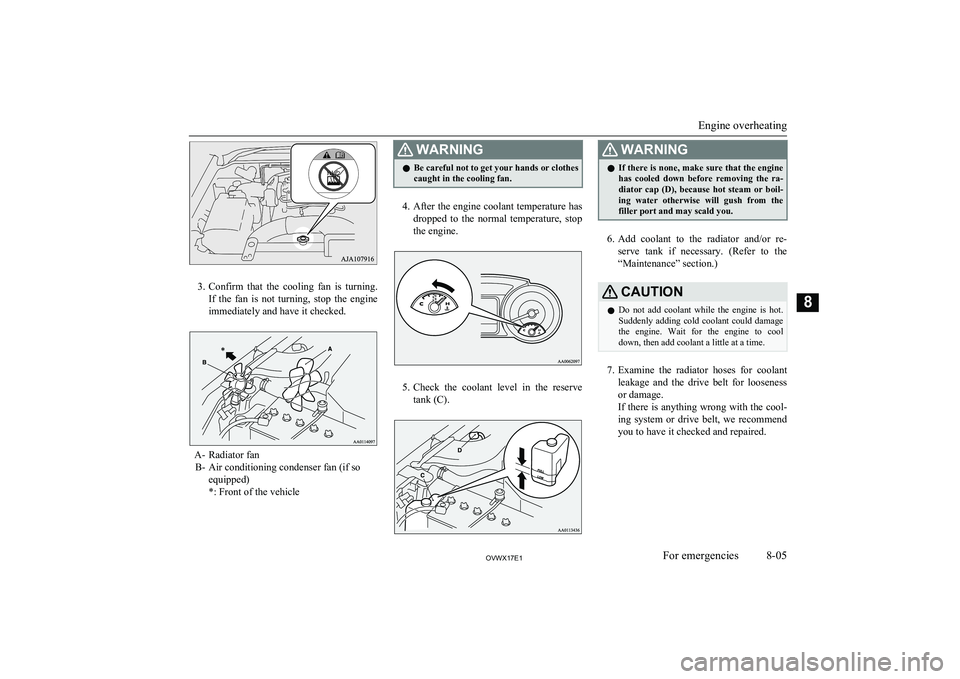
3.Confirm that the cooling fan is turning.
If the fan is not turning, stop the engine
immediately and have it checked.
A- Radiator fan B- Air conditioning condenser fan (if so equipped)
*: Front of the vehicle
WARNINGl Be careful not to get your hands or clothes
caught in the cooling fan.
4. After the engine coolant temperature has
dropped to the normal temperature, stop the engine.
5. Check the coolant level in the reserve
tank (C).
WARNINGl If there is none, make sure that the engine
has cooled down before removing the ra-
diator cap (D), because hot steam or boil- ing water otherwise will gush from the filler port and may scald you.
6. Add coolant to the radiator and/or re-
serve tank if necessary. (Refer to the
“Maintenance” section.)
CAUTIONl Do not add coolant while the engine is hot.
Suddenly adding cold coolant could damage
the engine. Wait for the engine to cool
down, then add coolant a little at a time.
7. Examine the radiator hoses for coolant
leakage and the drive belt for looseness
or damage.
If there is anything wrong with the cool-
ing system or drive belt, we recommend
you to have it checked and repaired.
Engine overheating
8-05OVWX17E1For emergencies8
Page 311 of 394
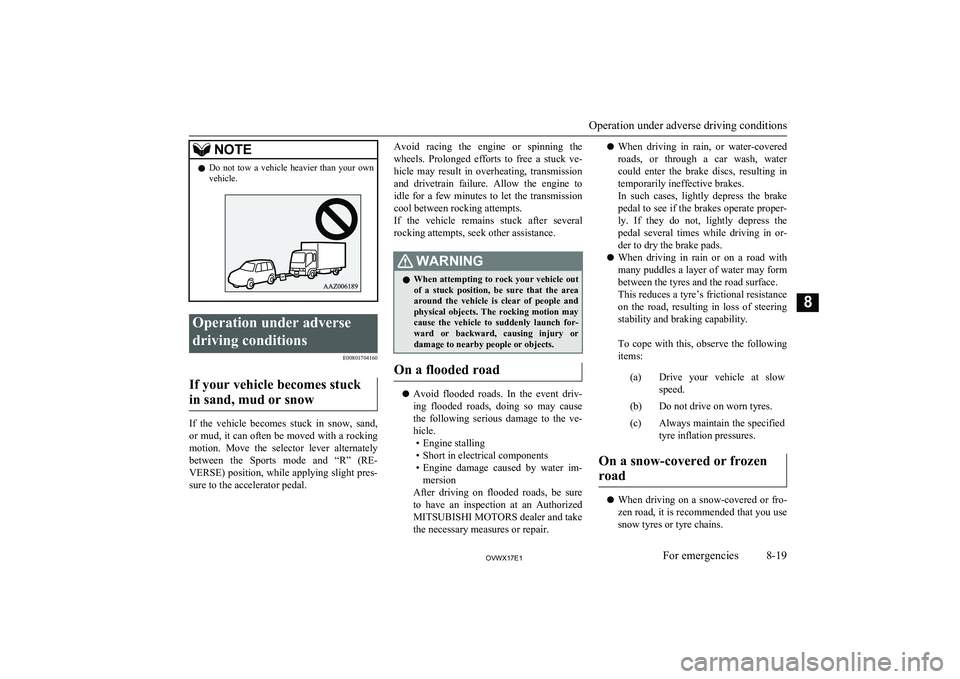
NOTElDo not tow a vehicle heavier than your own
vehicle.Operation under adverse
driving conditions E00801704160
If your vehicle becomes stuck
in sand, mud or snow
If the vehicle becomes stuck in snow, sand,
or mud, it can often be moved with a rocking
motion. Move the selector lever alternately
between the Sports mode and “R” (RE- VERSE) position, while applying slight pres-sure to the accelerator pedal.
Avoid racing the engine or spinning the
wheels. Prolonged efforts to free a stuck ve-hicle may result in overheating, transmission
and drivetrain failure. Allow the engine to idle for a few minutes to let the transmissioncool between rocking attempts.
If the vehicle remains stuck after several rocking attempts, seek other assistance.WARNINGl When attempting to rock your vehicle out
of a stuck position, be sure that the area around the vehicle is clear of people and
physical objects. The rocking motion may cause the vehicle to suddenly launch for-ward or backward, causing injury or
damage to nearby people or objects.
On a flooded road
l Avoid flooded roads. In the event driv-
ing flooded roads, doing so may causethe following serious damage to the ve-
hicle. • Engine stalling
• Short in electrical components
• Engine damage caused by water im-
mersion
After driving on flooded roads, be sure
to have an inspection at an Authorized MITSUBISHI MOTORS dealer and takethe necessary measures or repair.
l When driving in rain, or water-covered
roads, or through a car wash, water could enter the brake discs, resulting in
temporarily ineffective brakes.
In such cases, lightly depress the brake
pedal to see if the brakes operate proper- ly. If they do not, lightly depress the pedal several times while driving in or-
der to dry the brake pads.
l When driving in rain or on a road with
many puddles a layer of water may form
between the tyres and the road surface.
This reduces a tyre’s frictional resistance
on the road, resulting in loss of steering
stability and braking capability.
To cope with this, observe the following items: (a)Drive your vehicle at slow
speed. (b)Do not drive on worn tyres. (c)Always maintain the specified
tyre inflation pressures.
On a snow-covered or frozen
road
l When driving on a snow-covered or fro-
zen road, it is recommended that you use snow tyres or tyre chains.
Operation under adverse driving conditions
8-19OVWX17E1For emergencies8
Page 368 of 394
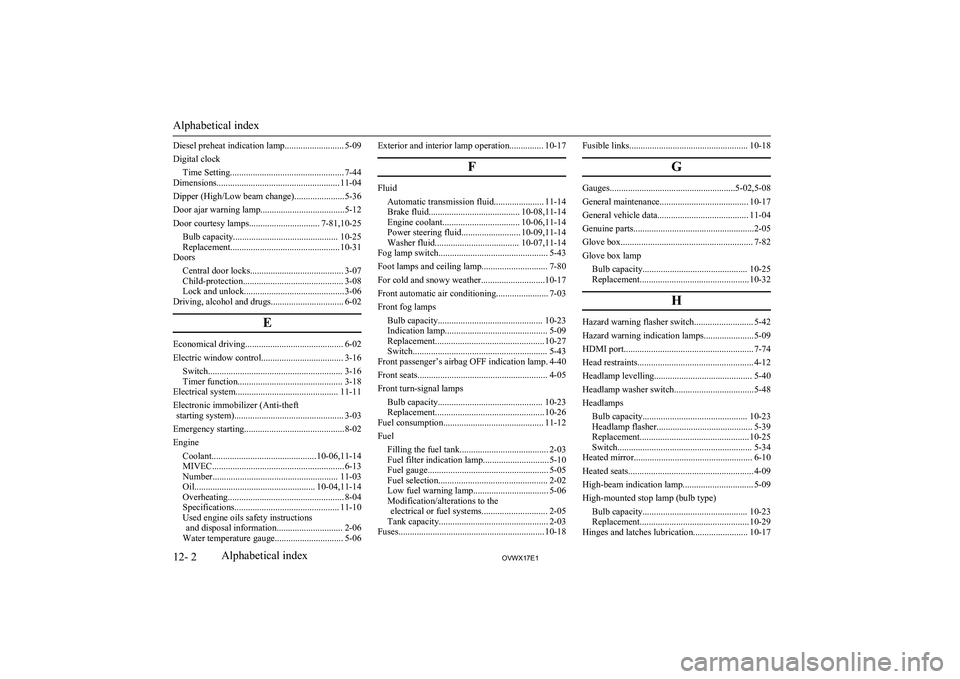
Diesel preheat indication lamp.......................... 5-09
Digital clock Time Setting.................................................. 7-44
Dimensions...................................................... 11-04
Dipper (High/Low beam change)......................5-36
Door ajar warning lamp.....................................5-12
Door courtesy lamps............................... 7-81,10-25
Bulb capacity.............................................. 10-25
Replacement................................................ 10-31
Doors
Central door locks......................................... 3-07
Child-protection............................................ 3-08
Lock and unlock............................................ 3-06
Driving, alcohol and drugs................................ 6-02
E
Economical driving........................................... 6-02
Electric window control.................................... 3-16 Switch........................................................... 3-16
Timer function.............................................. 3-18
Electrical system............................................. 11-11
Electronic immobilizer (Anti-theft starting system)................................................ 3-03
Emergency starting............................................8-02
Engine Coolant..............................................10-06,11-14MIVEC.......................................................... 6-13
Number....................................................... 11-03
Oil..................................................... 10-04,11-14
Overheating................................................... 8-04
Specifications.............................................. 11-10
Used engine oils safety instructions and disposal information............................. 2-06
Water temperature gauge.............................. 5-06
Exterior and interior lamp operation............... 10-17
F
FluidAutomatic transmission fluid...................... 11-14
Brake fluid........................................ 10-08,11-14
Engine coolant.................................. 10-06,11-14
Power steering fluid.......................... 10-09,11-14
Washer fluid..................................... 10-07,11-14
Fog lamp switch................................................ 5-43
Foot lamps and ceiling lamp............................. 7-80
For cold and snowy weather............................10-17
Front automatic air conditioning....................... 7-03
Front fog lamps Bulb capacity.............................................. 10-23
Indication lamp............................................. 5-09
Replacement................................................ 10-27
Switch........................................................... 5-43
Front passenger’s airbag OFF indication lamp. 4-40
Front seats......................................................... 4-05
Front turn-signal lamps Bulb capacity.............................................. 10-23
Replacement................................................ 10-26
Fuel consumption............................................ 11-12
Fuel
Filling the fuel tank....................................... 2-03Fuel filter indication lamp............................. 5-10
Fuel gauge..................................................... 5-05 Fuel selection................................................ 2-02
Low fuel warning lamp................................. 5-06
Modification/alterations to the electrical or fuel systems............................. 2-05
Tank capacity................................................ 2-03
Fuses................................................................ 10-18
Fusible links.................................................... 10-18
G
Gauges.......................................................5-02,5-08
General maintenance....................................... 10-17
General vehicle data........................................ 11-04
Genuine parts.....................................................2-05
Glove box.......................................................... 7-82
Glove box lamp Bulb capacity.............................................. 10-25
Replacement................................................ 10-32
H
Hazard warning flasher switch.......................... 5-42
Hazard warning indication lamps......................5-09
HDMI port......................................................... 7-74
Head restraints................................................... 4-12
Headlamp levelling........................................... 5-40
Headlamp washer switch...................................5-48
Headlamps Bulb capacity.............................................. 10-23
Headlamp flasher.......................................... 5-39 Replacement................................................ 10-25
Switch........................................................... 5-34
Heated mirror.................................................... 6-10
Heated seats....................................................... 4-09
High-beam indication lamp............................... 5-09
High-mounted stop lamp (bulb type) Bulb capacity.............................................. 10-23
Replacement................................................ 10-29
Hinges and latches lubrication........................ 10-17
Alphabetical index
12- 2 OVWX17E1Alphabetical index